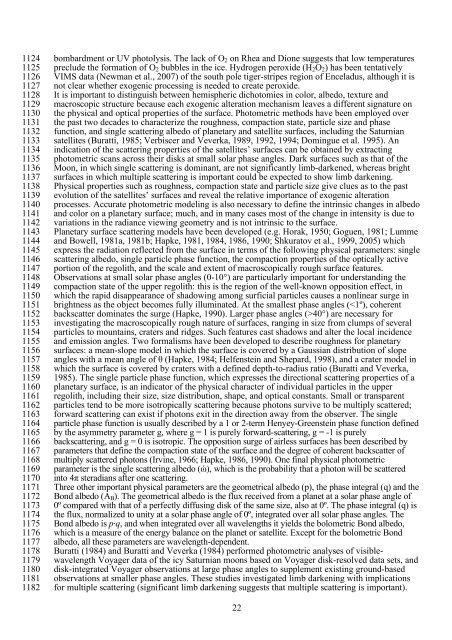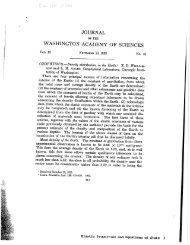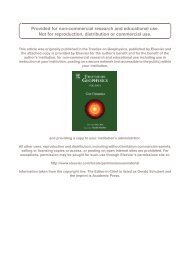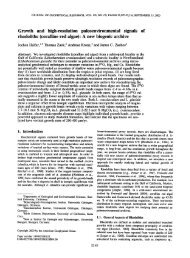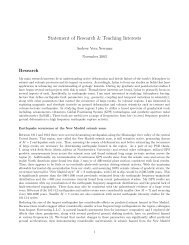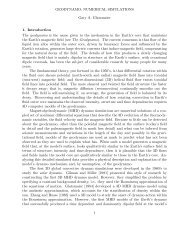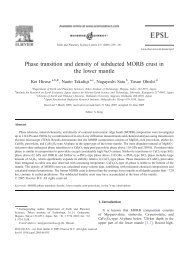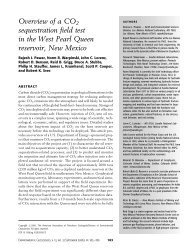Reprint - Earth & Planetary Sciences - University of California, Santa ...
Reprint - Earth & Planetary Sciences - University of California, Santa ...
Reprint - Earth & Planetary Sciences - University of California, Santa ...
You also want an ePaper? Increase the reach of your titles
YUMPU automatically turns print PDFs into web optimized ePapers that Google loves.
1124<br />
1125<br />
1126<br />
bombardment or UV photolysis. The lack <strong>of</strong> O2 on Rhea and Dione suggests that low temperatures<br />
preclude the formation <strong>of</strong> O2 bubbles in the ice. Hydrogen peroxide (H2O2) has been tentatively<br />
VIMS data (Newman et al., 2007) <strong>of</strong> the south pole tiger-stripes region <strong>of</strong> Enceladus, although it is<br />
1127 not clear whether exogenic processing is needed to create peroxide.<br />
1128 It is important to distinguish between hemispheric dichotomies in color, albedo, texture and<br />
1129 macroscopic structure because each exogenic alteration mechanism leaves a different signature on<br />
1130 the physical and optical properties <strong>of</strong> the surface. Photometric methods have been employed over<br />
1131 the past two decades to characterize the roughness, compaction state, particle size and phase<br />
1132 function, and single scattering albedo <strong>of</strong> planetary and satellite surfaces, including the Saturnian<br />
1133 satellites (Buratti, 1985; Verbiscer and Veverka, 1989, 1992, 1994; Domingue et al. 1995). An<br />
1134 indication <strong>of</strong> the scattering properties <strong>of</strong> the satellites’ surfaces can be obtained by extracting<br />
1135 photometric scans across their disks at small solar phase angles. Dark surfaces such as that <strong>of</strong> the<br />
1136 Moon, in which single scattering is dominant, are not significantly limb-darkened, whereas bright<br />
1137 surfaces in which multiple scattering is important could be expected to show limb darkening.<br />
1138 Physical properties such as roughness, compaction state and particle size give clues as to the past<br />
1139 evolution <strong>of</strong> the satellites’ surfaces and reveal the relative importance <strong>of</strong> exogenic alteration<br />
1140 processes. Accurate photometric modeling is also necessary to define the intrinsic changes in albedo<br />
1141 and color on a planetary surface; much, and in many cases most <strong>of</strong> the change in intensity is due to<br />
1142 variations in the radiance viewing geometry and is not intrinsic to the surface.<br />
1143 <strong>Planetary</strong> surface scattering models have been developed (e.g. Horak, 1950; Goguen, 1981; Lumme<br />
1144<br />
1145<br />
and Bowell, 1981a, 1981b; Hapke, 1981, 1984, 1986, 1990; Shkuratov et al., 1999, 2005) which<br />
express the radiation reflected from the surface in terms <strong>of</strong> the following physical parameters: single<br />
1146 scattering albedo, single particle phase function, the compaction properties <strong>of</strong> the optically active<br />
1147 portion <strong>of</strong> the regolith, and the scale and extent <strong>of</strong> macroscopically rough surface features.<br />
1148 Observations at small solar phase angles (0-10°) are particularly important for understanding the<br />
1149 compaction state <strong>of</strong> the upper regolith: this is the region <strong>of</strong> the well-known opposition effect, in<br />
1150 which the rapid disappearance <strong>of</strong> shadowing among surficial particles causes a nonlinear surge in<br />
1151 brightness as the object becomes fully illuminated. At the smallest phase angles (40°) are necessary for<br />
1153 investigating the macroscopically rough nature <strong>of</strong> surfaces, ranging in size from clumps <strong>of</strong> several<br />
1154 particles to mountains, craters and ridges. Such features cast shadows and alter the local incidence<br />
1155 and emission angles. Two formalisms have been developed to describe roughness for planetary<br />
1156 surfaces: a mean-slope model in which the surface is covered by a Gaussian distribution <strong>of</strong> slope<br />
1157 angles with a mean angle <strong>of</strong> θ (Hapke, 1984; Helfenstein and Shepard, 1998), and a crater model in<br />
1158 which the surface is covered by craters with a defined depth-to-radius ratio (Buratti and Veverka,<br />
1159 1985). The single particle phase function, which expresses the directional scattering properties <strong>of</strong> a<br />
1160 planetary surface, is an indicator <strong>of</strong> the physical character <strong>of</strong> individual particles in the upper<br />
1161 regolith, including their size, size distribution, shape, and optical constants. Small or transparent<br />
1162 particles tend to be more isotropically scattering because photons survive to be multiply scattered;<br />
1163 forward scattering can exist if photons exit in the direction away from the observer. The single<br />
1164 particle phase function is usually described by a 1 or 2-term Henyey-Greenstein phase function defined<br />
1165 by the asymmetry parameter g, where g = 1 is purely forward-scattering, g = -1 is purely<br />
1166<br />
1167<br />
backscattering, and g = 0 is isotropic. The opposition surge <strong>of</strong> airless surfaces has been described by<br />
parameters that define the compaction state <strong>of</strong> the surface and the degree <strong>of</strong> coherent backscatter <strong>of</strong><br />
1168 multiply scattered photons (Irvine, 1966; Hapke, 1986, 1990). One final physical photometric<br />
1169 parameter is the single scattering albedo (ώ), which is the probability that a photon will be scattered<br />
1170 into 4π steradians after one scattering.<br />
1171 Three other important physical parameters are the geometrical albedo (p), the phase integral (q) and the<br />
1172<br />
1173<br />
Bond albedo (AB). The geometrical albedo is the flux received from a planet at a solar phase angle <strong>of</strong><br />
0º compared with that <strong>of</strong> a perfectly diffusing disk <strong>of</strong> the same size, also at 0º. The phase integral (q) is<br />
1174 the flux, normalized to unity at a solar phase angle <strong>of</strong> 0º, integrated over all solar phase angles. The<br />
1175 Bond albedo is p·q, and when integrated over all wavelengths it yields the bolometric Bond albedo,<br />
1176 which is a measure <strong>of</strong> the energy balance on the planet or satellite. Except for the bolometric Bond<br />
1177 albedo, all these parameters are wavelength-dependent.<br />
1178 Buratti (1984) and Buratti and Veverka (1984) performed photometric analyses <strong>of</strong> visible-<br />
1179 wavelength Voyager data <strong>of</strong> the icy Saturnian moons based on Voyager disk-resolved data sets, and<br />
1180 disk-integrated Voyager observations at large phase angles to supplement existing ground-based<br />
1181 observations at smaller phase angles. These studies investigated limb darkening with implications<br />
1182<br />
for multiple scattering (significant limb darkening suggests that multiple scattering is important).<br />
22


